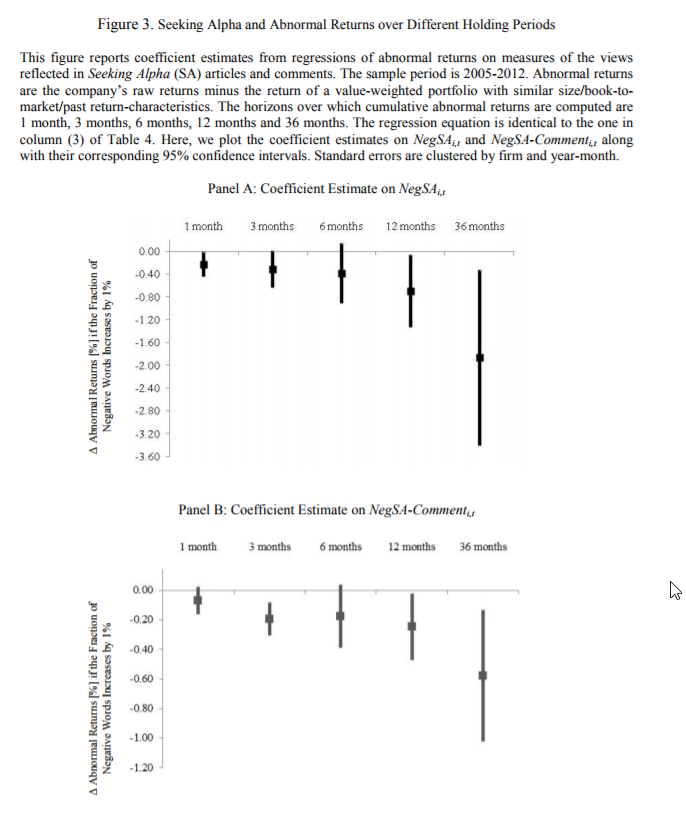Wisdom of the Crowds: The Value of Stock Opinions Transmitted Through Social Media
- Hailiang Chen, Prabuddha De, Yu Jeffrey Hu, Byoung Hyoun Hwang
- Review of Financial Studies, 2014, vol. 27, no. 5, pages 1367-1403.
- A version of this paper can be found here
- Want to read our summaries of academic finance papers? Check out our Academic Research Insight category.
What are the research questions?
- Do peer opinions impart value-relevant news or are they merely random chatter (value-relevance hypothesis)?
- Do peer opinions predict subsequent earnings surprises?
What are the Academic Insights?
By employing textual analysis (focusing on the fraction of negative words both in SA articles and follow-up comments), the authors study user-generated opinions from Seeking Alpha (SA) on a sample of more than 7,000 companies during 2005-2012 and find the following:
- YES- views expressed on SA are generally confirmed by subsequent stock market performance. Future abnormal returns are 0.38% lower when the fraction of negative words in SA articles is 1% higher and 0.19% lower when the fraction of negative words in SA comments is 1% higher. This prediction holds over different investment horizons and they tend to increase with the length of the holding period.
- YES- views expressed on SA are generally confirmed by subsequent earnings further below market expectations as measured by financial analysts’forecasts.
The authors perform a number of robustness checks like the inclusion of control variables reflecting analyst recommendation upgrades/downgrades, positive/negative earnings surprises and the negative fraction of negative words in the DJNS articles.
Why does it matter?
With the usual caveat that sample size is limited, this study adds to the literature studying the usefulness of the internet as a source of valuable information and specifically, the usefulness of peer-based advice in financial markets.
The Most Important Chart from the Paper:

The results are hypothetical results and are NOT an indicator of future results and do NOT represent returns that any investor actually attained. Indexes are unmanaged, do not reflect management or trading fees, and one cannot invest directly in an index.
Abstract
Social media has become a popular venue for individuals to share the results of their own analysis on financial securities. This paper investigates the extent to which investor opinions transmitted through social media predict future stock returns and earnings surprises. We conduct textual analysis of articles published on one of the most popular social-media platforms for investors in the United States. We also consider the readers’ perspective as inferred via commentaries written in response to these articles. We find that the views expressed in both articles and commentaries predict future stock returns and earnings surprises.
About the Author: Wesley Gray, PhD
—
Important Disclosures
For informational and educational purposes only and should not be construed as specific investment, accounting, legal, or tax advice. Certain information is deemed to be reliable, but its accuracy and completeness cannot be guaranteed. Third party information may become outdated or otherwise superseded without notice. Neither the Securities and Exchange Commission (SEC) nor any other federal or state agency has approved, determined the accuracy, or confirmed the adequacy of this article.
The views and opinions expressed herein are those of the author and do not necessarily reflect the views of Alpha Architect, its affiliates or its employees. Our full disclosures are available here. Definitions of common statistics used in our analysis are available here (towards the bottom).
Join thousands of other readers and subscribe to our blog.

